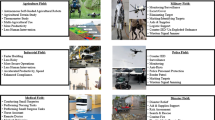Abstract
With the widespread use of service robots, safety issues regarding human-robot collisions have received increasing attention. The collision detection algorithm, which allows a robot to effectively detect and react against a collision, is considered as one of the most practical solutions for ensuring collision safety. However, these algorithms are often model-based, so it cannot ensure collision safety under payload variations or model uncertainty. In this paper, a novel collision detection algorithm based on torque filtering is proposed to cope with this problem. The torque due to the motion of the robot can be effectively removed using the Butterworth 2nd-order BPF (band pass filter) so that only the torque due to a collision is used for collision detection. This improves the robustness of the algorithm against model uncertainties. The proposed algorithm does not require the use of acceleration data. The performance of the algorithm was experimentally verified.
Similar content being viewed by others
References
B. S. Kim, J. J. Park, and J. B. Song, “A serial-type dual actuator unit with planetary gear train: basic design and applications,” IEEE/ASME Trans. on Mechatronics, vol. 15, no. 1, pp. 108–116, 2010.
S. Morikawa, T. Senoo, A. Namiki, and M. Ishikawa, “Realtime collision avoidance using a robot manipulator with light-weight high-speed vision system,” Proc. of the IEEE Int. Conf. on Robotics and Automation, pp. 794–799, 2007.
S. Takakura, T. Murakami, and K. Ohnishi, “An approach to collision detection and recovery motion in industrial robot,” Proc. of 15th Int. Conf. on Advanced Robotics, pp. 421–426, 1989.
A. De Luca, A. Albu-Schaffer, S. Haddadin, and G. Hirzinger, “Collision detection and safe reaction with the DLR-III lightweight manipulator arm,” Proc. of the IEEE/RSJ Int. Conf. on Intelligent Robotics and Systems, pp. 1623–1630, 2006.
J. W. Seok, W. J. Yoo, and S. C. Won, “Inertiarelated coupling torque compensator for disturbance observer based position control of robotic manipulators,” International Journal of Control, Automation, and Systems, vol. 10, no. 4, pp. 753–760, 2012.
A. De Luca and R. Mattone, “An adapt-and-detect actuator FDI scheme for robot manipulators,” Proc. of the IEEE Int. Conf. on Robotics and Automation, pp. 4975–4980, 2004.
F. L. Lewis, D. M. Dawson, and C. T. Abdallah, Robot Manipulator Control: Theory and Practice, Marcel Dekker, Inc., New York, 2003.
L. A. Dessaint, M. Saad, B. Hebert, and S. Robert, “Real-time implementation of an indirect adaptive robot controller,” International Journal of Adaptive Control and Signal Processing, vol. 9, no. 4, pp. 369–381, July/August 1995.
J. H. Kim, Y. L. Kim, and J. B. Song, “Collision detection algorithm to distinguish between intended contact and unexpected collision,” Proc. of Int. Conf. on Ubiquitous Robots and Ambient Intelligence, pp. 221–224, 2010.
W. Li and J.-J. E. Slotine, “An indirect adaptive robot controller,” Systems & Control Letters, vol. 12, no. 3, pp. 259–266, April 1989.
Y. Yamamoto, B. D. Anderson, M. Nagahara, and Y. Koyanagi, “Optimizing FIR approximation for discrete time IIR filters,” IEEE Signal Processing Letters, vol. 10, no. 9, pp. 273–276, 2003.
S. Haddadin, A. Albu-Schaffer, and G. Hirzinger, “Safety evaluation of physical human-robot interaction via crash-testing,” in Robotics: Science and System Conf., pp. 217–224, 2007.
Author information
Authors and Affiliations
Corresponding author
Additional information
Recommended by Editorial Board member Youngjin Choi under the direction of Editor Hyouk Ryeol Choi.
This work was supported by the Human Resources Development Program for Convergence Robot Specialists and by Korea University Research Fund.
Chang-Nho Cho received his B.S. degree in Applied Science from the University of British Columbia, Vancouver, Canada, in 2010. He received his M.S degree in Mechanical Engineering from Korea University. His research interests include safe human-robot interactions and human-robot cooperation.
Jae-Bok Song received his B.S. and M.S. degrees in Mechanical Engineering from Seoul National University, in 1983 and 1985, respectively, and his Ph.D. degree in Mechanical Engineering from MIT in 1992. He joined the faculty of Korea University in 1993. His current research interests include design and control of robot arms and navigation of a mobile robot.
Rights and permissions
About this article
Cite this article
ho, CN., Song, JB. Collision detection algorithm robust to model uncertainty. Int. J. Control Autom. Syst. 11, 776–781 (2013). https://doi.org/10.1007/s12555-012-0235-6
Received:
Accepted:
Published:
Issue Date:
DOI: https://doi.org/10.1007/s12555-012-0235-6




